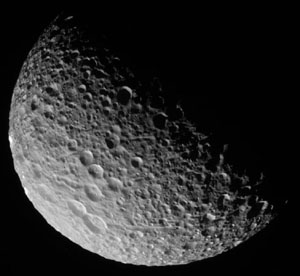Rev12 Mimas Encounter

This evening PDT, Cassini will make its closest approach to Mimas for the entire nominal mission. At 9:46pm PDT (ERT), or 04:22 UTC SCET, Cassini will fly within 62,074 km of Mimas' battered surface. This will provide Cassini's best look at Mimas for the entire tour and will provide some of our first decent views of this satellite's south polar region. The south pole of a number of satellites have been highlighted for the last few orbits due to Cassini's currently high inclination. Unfortunately, Mimas is the only major satellite that does not get a targeted flyby in the nominal tour, and unless something major is found during this pass, I doubt it would be a target for one in an extended mission. In addition to Mimas, Dione and Rhea non-targeted encounters are highlighted on this orbit.
Mimas is a relatively small satellite, only 400 km across. Its surface is heavily battered, with numerous impacts filling the surface to saturation. Its near twin in the Saturnian system, Enceladus, has some heavily cratered regions, but even those areas on its surface appear younger than Mimas. Some tectonic chasms can be seen criss-crossing its surface, including one east of Herschel, known as Camelot Chasma, and Ossa Chasma shown above. Unlike Enceladus, where tectonic fractures are likely related to internal heat, fractures on Mimas, given its heavily cratered surface, are likely related to stress caused by Herschel and other large impacts.
This encounter of Mimas will highlight the anti-Saturnian hemisphere of Mimas, particularly the southern regions. At the start of the encounter, Herschel will be near the evening terminator and will cross it and start to go beyond the limb as the encounter progresses. As Herschel pulls out of view, another large crater known as Arthur will pull into view. To the southwest of Arthur is another large central peak crater named Merlin. As we approach Mimas, more of the northern hemisphere comes into view, providing a good look at regions not seen by Voyager and toward a crater known as Morgan. As we pass closest approach we are left with a decent look at the northern reaches of the trailing hemisphere.
Mimas isn't the only world to be highlighted during this orbit. Today, Cassini flys within 206,000 km of Rhea and Dione. Rhea's south polar region, like during the last orbit, should be on full display, but this time the trailing hemisphere will be lit. Images of Dione's wispy terrain could be obtained during this encounter.
UPDATE: 12:35pm: some of the links farther down don't work because Blogger likes to reformat my links. I will try to find a correction... links fixed.
UPDATE: 1:05pm: Björn Jónsson has produced an animation showing the geometry of the Mimas encounter that is definitely worth checking out. The file size is 7MB but is worth the download.


3 Comments:
Thanks very much for the summary of the encounter, Jason. I wish the official website would devote at least some attention to these nontargeted flybys, especially this one, because as you say it's the best look Cassini will get at Mimas. (I just hope they'll share the Mimas pictures at all -- the raw images website still hasn't started back up again since conjunction. I'm growing to hate that nightside wide-angle image of Saturn from July 20 that heads the latest images list.)
What kinds of imaging observations are planned? Is the imaging team producing a map of planned coverage like you have for the Titan and Enceladus flybys in the past?
well, they may be showing up soon as there are are pages for images from after conjunction. And besides, they have till tomorrow or Wednesday afternoon to have the bugs worked out.
Raw images page fixed :-D
Post a Comment
<< Home